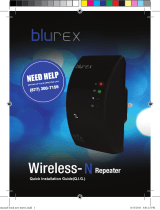
© Copyright 2015 TRENDnet. All Rights Reserved.
Table of Contents
Product Overview ........................................................................... 1
Package Contents .......................................................................................................... 1
Features ......................................................................................................................... 1
Product Hardware Features........................................................................................... 2
Application Diagram ...................................................................................................... 3
Router Setup ................................................................................... 4
Creating a Home Network ............................................................................................. 4
Router Installation ......................................................................................................... 5
Connect additional wired devices to your network ....................................................... 8
Basic Router Settings ....................................................................... 9
Access your router management page .......................................................................... 9
Network Status .............................................................................................................. 9
Wireless Settings ......................................................................................................... 10
Guest Network ............................................................................................................. 12
Parental Control ........................................................................................................... 13
Access Rule (MAC/IP Filter) ............................................................................... 13
Website Filter..................................................................................................... 15
Qualcomm® StreamBoost™ ........................................................... 16
Enable StreamBoost .......................................................................................... 16
My Network ....................................................................................................... 17
Priorities ............................................................................................................. 19
Usage by Time .................................................................................................... 19
Usage by Data .................................................................................................... 20
Wireless Networking and Security ................................................. 21
How to choose the type of security for your wireless network .................................. 21
Secure your wireless network ..................................................................................... 22
Connect wireless devices to your router ..................................................................... 24
Connect wireless devices using WPS ........................................................................... 24
PBC (Software/Virtual Push Button) .................................................................. 25
PIN (Personal Identification Number)................................................................ 25
MAC Filter (Wireless) ................................................................................................... 26
Advanced wireless settings ......................................................................................... 27
Multiple SSID ..................................................................................................... 27
Advanced Settings ............................................................................................. 28
Steps to improve wireless connectivity ....................................................................... 30
Advanced Router Settings ............................................................. 31
Change your router login password ............................................................................ 31
Manually configure your Internet connection ............................................................ 31
IPv6 Settings ................................................................................................................ 32
Clone a MAC address ................................................................................................... 33
Change your router IP address .................................................................................... 33
Set up the DHCP server on your router ....................................................................... 34
Set up DHCP reservation ............................................................................................. 35
Enable/disable UPnP on your router ........................................................................... 36
Enable/disable Application Layer Gateways (ALG) ...................................................... 36
Allow/deny multicast streaming.................................................................................. 37
Identify your network on the Internet ........................................................................ 37
Set your router date and time ..................................................................................... 38
Create schedules ......................................................................................................... 39
Access Control (IP Protocol Filter) ............................................................................... 40
Inbound Filter .............................................................................................................. 41
Open a device on your network to the Internet .......................................................... 42
DMZ ................................................................................................................... 42
Virtual Server ..................................................................................................... 42
Special Applications ........................................................................................... 44





















